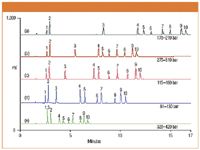Use of Alternative Solvents for Liquid Chromatographic Analysis of Cationic Surfactants
Cationic surfactants are used as disinfectants, corrosion inhibitors, phase-transfer catalysts, wetting agents, dispersants, and even mobile phase modifiers in liquid chromatography.
Mark Tracy and Xiaodong Liu, Dionex Corporation
Cationic surfactants are used as disinfectants, corrosion inhibitors, phase-transfer catalysts, wetting agents, dispersants, and even mobile phase modifiers in liquid chromatography. They face two difficulties for successful analysis by LC. First, they tend to have very poor peak shape on conventional reversed-phase columns due to strong ionic interactions with residual silanol groups. Second, many cationic surfactants have no useful UV chromophore. The first problem may be solved by the use of specialized columns. The second problem may be solved by the use of mass spectrometry, charged aerosol detection (CAD), or evaporative light scattering detection (ELSD) with a volatile mobile phase.
The Acclaim® Surfactant is a high-efficiency, silica-based, specialty reversed-phase column designed for the analysis of anionic, cationic, nonionic, and zwitterionic surfactants. Here, the authors compare acetonitrile and four less expensive and less toxic solvents — methanol, ethanol, isopropanol, and acetone for the analysis of cationic surfactants using ELSD.
Experimental Conditions
UltiMate® HPG 3400 RS pump, WPS 3000 TRS sampler, TCC 3000 column oven (Dionex Corporation, Sunnyvale, CA) and SofTA model 1400 evaporative light scattering detector (SofTA Corporation, Westminster, CO). Acetonitrile and methanol UV grade from B&J; ethanol, denatured 3A from BDH; isopropanol and acetone, semiconductor grade from General Chemical.
Results and Discussion
Figure 1 shows a comparison of the chromatograms of the five solvents under the same gradient program. Compared to acetonitrile (trace d), isopropanol (e) was a stronger solvent, while acetone (c), ethanol (b), and methanol (a) were the weaker solvents. The selectivity, efficiency, and resolution were quite similar for acetonitrile and acetone. Alcohols have higher viscosity than acetonitrile or acetone, which results in high operating pressures (as noted in Figure 1) and lower peak efficiency.

Figure 1: Alternative solvents for the analysis of cationic surfactants. Column: Acclaim Surfactant 3 µm, 3 à 150 mm; column temperature: 25 °C; flow rate: 0.425 mL/min; ELSD spray temperature: 55 °C; drift tube: 65 °C. Gradient program: initially at 35% organic solvent until 1.0 min; linear gradient to 75% organic until 13.5 min; maintained at 75% organic until 17.0 min. Mobile phases: buffer, 100 mM acetic acid in water, adjusted to pH 5.0 with ammonium hydroxide; organic solvent (a) methanol; (b) ethanol; (c) acetone; (d) acetonitrile; (e) isopropanol. Components approx. 75 µg/mL: 1. chloride; 2. bromide; 3. decyltrimethylammonium; 4. dodecyltrimethylammonium; 5. dodecylpyridinium; 6. dodecylbenzyldimethylammonium; 7. tetradecyltrimethylammonium; 8. tetradecylbenzyldimethylammonium; 9. hexadecyltrimethylammonium; 10. hexadecylpyridinium.
Conclusion
The Acclaim Surfactant column provides excellent separation capability for cationic surfactants. Several less-toxic, lower-cost, and more readily available solvents can replace acetonitrile. When using ELSD or CAD detectors, acetone can substitute for acetonitrile. When UV detection is required, methanol and ethanol are useful alternatives.
Acclaim and UltiMate are registered trademarks of Dionex Corporation.

Dionex Corporation
1228 Titan Way, P.O. Box 3603, Sunnyvale, CA 94088
tel. (408) 737-0700; fax (408) 730-9403
Website: www.dionex.com

Automated Sample Preparation (ISO 20122) for MOSH/MOAH in Seasoning Oils
May 6th 2025This work presents an Automated Sample Preparation procedure for MOSH/MOAH analysis of Seasoning Oils. We compare results from a manual epoxidation procedure compliant with DIN 16995 with results based on fully automated sample preparation (epoxidation and saponification) compliant with ISO 20122. In both cases, online clean-up via activated aluminum oxide (AlOx) are used to remove interfering n-alkanes from the MOSH fraction during the HPLC run. Automated data evaluation using a dedicated software (GERSTEL ChroMOH) is presented.
Free Poster: NDSRI Risk Assessment and Trace-Level Analysis of N-Nitrosamines
April 25th 2025With increasing concern over genotoxic nitrosamine contaminants, regulatory bodies like the FDA and EMA have introduced strict guidelines following several high-profile drug recalls. This poster showcases a case study where LGC and Waters developed a UPLC/MS/MS method for quantifying trace levels of N-nitroso-sertraline in sertraline using Waters mass spectrometry and LGC reference standards.

.png&w=3840&q=75)

.png&w=3840&q=75)



.png&w=3840&q=75)



.png&w=3840&q=75)














